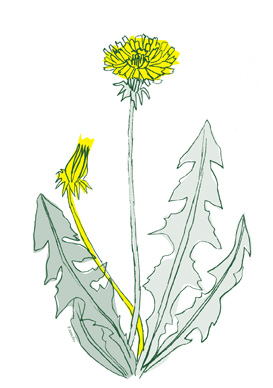
Dandelion {leaf, root, and flower}
“Eat yer weeds” proverb of the Ale Wife
There is magic in this backyard “weed”.
The tender, dark green, mineral-rich leaves of spring are delicious in a salad. The leaf and the root can be harvested and prepared as teas or tinctures for liver or kidney support (seek professional guidance for specifics). Collect four quarts of golden dandelion blossoms for your next potent batch of dandelion wine.
Dandelion Wine:
ingredients, methods, and tasting notes
Taraxacum officinale- Dandelion
Four good quarts of dandelion blossoms, four pounds of sugar, six oranges, five lemons. Wash dandelion blossoms and place them in an earthenware crock. Pour five quarts of boiling water over them and let stand 36 hours. Then strain through a muslin bag, squeezing out all moisture from dandelions. Put the strained juice in a deep stone crock or jug and add to it the grated rind and juice of the six oranges and five lemons. Tie a piece of cheese-cloth over the top of jug and stand it in a warm kitchen about one week, until it begins to ferment. Then stand away from stove in an outer kitchen or cooler place, not in the cellar, for three months. At the end of three months put in bottles. This is a clear, amber, almost colorless liquid. A pleasant drink of medicinal value. Aunt Sarah always used this recipe for making dandelion wine, but Mary preferred a recipe in which yeast was used, as the wine could be used a short time after making.”
For dandelion wine made with yeast: “Four quarts of dandelion blossoms. Pour over them four quarts of boiling water; let stand 24 hours, strain and add grated rind and juice of two oranges and two lemons, four pounds of granulated sugar and two tablespoonfuls of home-made yeast. Let stand one week, then strain and fill bottles.” Source: “Mary at the Farm and Book of Recipes Compiled During Her Visit Among the “Pennsylvania Germans,” by Edith M. Thomas, 1915.
DISCLAIMER: if you make dandelion wine using either of these recipes, you do so at your own risk.